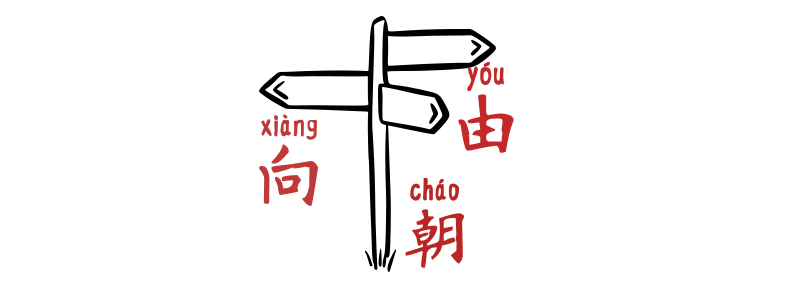Grammar Point:
All three of these, 向 xiàng, 朝 cháo, and 由 yóu can be used to indicate direction or position in Chinese. However, they have slightly different nuances and usages:
向 xiàng
It is used to indicate a specific direction or the target of an action. It can also be used to express “towards” or “to.”
向 + Specific Target + Concrete Verb
我的狗向我撒嬌我的狗向我撒娇
My dog cozies up to me.
請你向我仔細說明情況请你向我仔细说明情况
Please explain the situation to me in detail.
事情已經發生了,你向我大吼也沒用事情已经发生了,你向我大吼也没用
It has already happened, and yelling at me won’t help.
孩子向媽媽吵著要吃糖孩子向妈妈吵着要吃糖
The child is arguing with his mom to get some candy.
向 + Specific Target + Abstract Verb
我們應該向他道歉我们应该向他道歉
We should apologize to him.
學生向老師問好学生向老师问好
The student greets the teacher.
你應該多向前輩請教你应该多向前辈请教
You should seek advice from seniors more.
我要多向貓學習,跟貓一樣不在意別人的眼光我要多向猫学习,跟猫一样不在意别人的眼光
I want to learn more from cats and be just like them, not caring about other people’s opinions.
朝 cháo
It is used to indicate a direction or orientation. It can also express “towards” or “to.” This preposition is often used in a more formal or literary context.
朝 + Direction + Verb
大門朝南開大门朝南开
The main entrance faces south.
他朝我這邊看了一下他朝我这儿看了一会儿
He looked in my direction for a while.
穆斯林們朝麥加的方向朝拜穆斯林们朝麦加的方向朝拜
Muslims pray in the direction of Mecca.
颱風正朝著福建的方向移動台风正朝着福建的方向移动
The typhoon is moving in the direction of Fujian.
朝 + Specific Target + Concrete Verb
事情已經發生了,你朝我大吼也沒用事情已经发生了,你朝我大吼也没用
It has already happened, and yelling at me won’t help.
森林大火逐漸朝都市燒過來森林大火逐渐朝都市烧过来
The forest fire is gradually spreading towards the city.
爺爺朝我丟了一顆糖爷爷朝我丢了一颗糖
Grandpa threw a candy at me.
我朝那個混蛋揍了一拳我朝那个混蛋揍了一拳
I punched that jerk.
由 yóu
It is used to indicate the origin or starting point of movement, expressing “from” or “since.” It is often used in a more formal or literary context.
由 + Place 1 + 向/到/往/朝 + Place 2
由上到下,由左到右由上到下,由左到右
From top to bottom, from left to right.
這路公車由故宮出發这路公交车由故宫出发
This bus departs from the Palace Museum.
我們由公司的後門進入我们由公司的后门进入
We enter through the back door of the company.
由我家朝外看可以看到台北101由我家朝外看可以看到台北101
From my home, looking outside, you can see Taipei 101.

Taipei 101
When it was completed in 2004, Taipei 101 held the title of the tallest building in the world, standing at 101 floors and reaching a height of 508 meters (1,667 feet). The number “101” was chosen to symbolize the building’s association with Taipei, showcasing the city’s significance and prominence on the global stage.
Taipei 101
In Taipei 101, you can take a thrilling ride in one of the world’s fastest elevators, which will whisk you up to the observation deck on the 89th floor. From here, get ready to be amazed by stunning views of Taipei’s cityscape, mountains, and sparkling waters.

Common Mistakes
我還沒朝她道謝我还没朝她道谢 ❌
I haven’t thanked her yet.
(Only 向 xiàng can go with “target + verb”)
Practice
TouchHover over the space to see the answers.
✔️ I resigned from my boss.
我向老闆請辭我向老板请辞
✔️ The boss yelled at me, telling me never to come back again.
老闆朝我大喊,要我永遠別想回來老板朝我大喊,要我永远别想回来
✔️ After leaving the company, my quality of life has improved a lot.
由公司離職後,我的生活品質變得很好由公司离职后,我的生活品质变得很好


